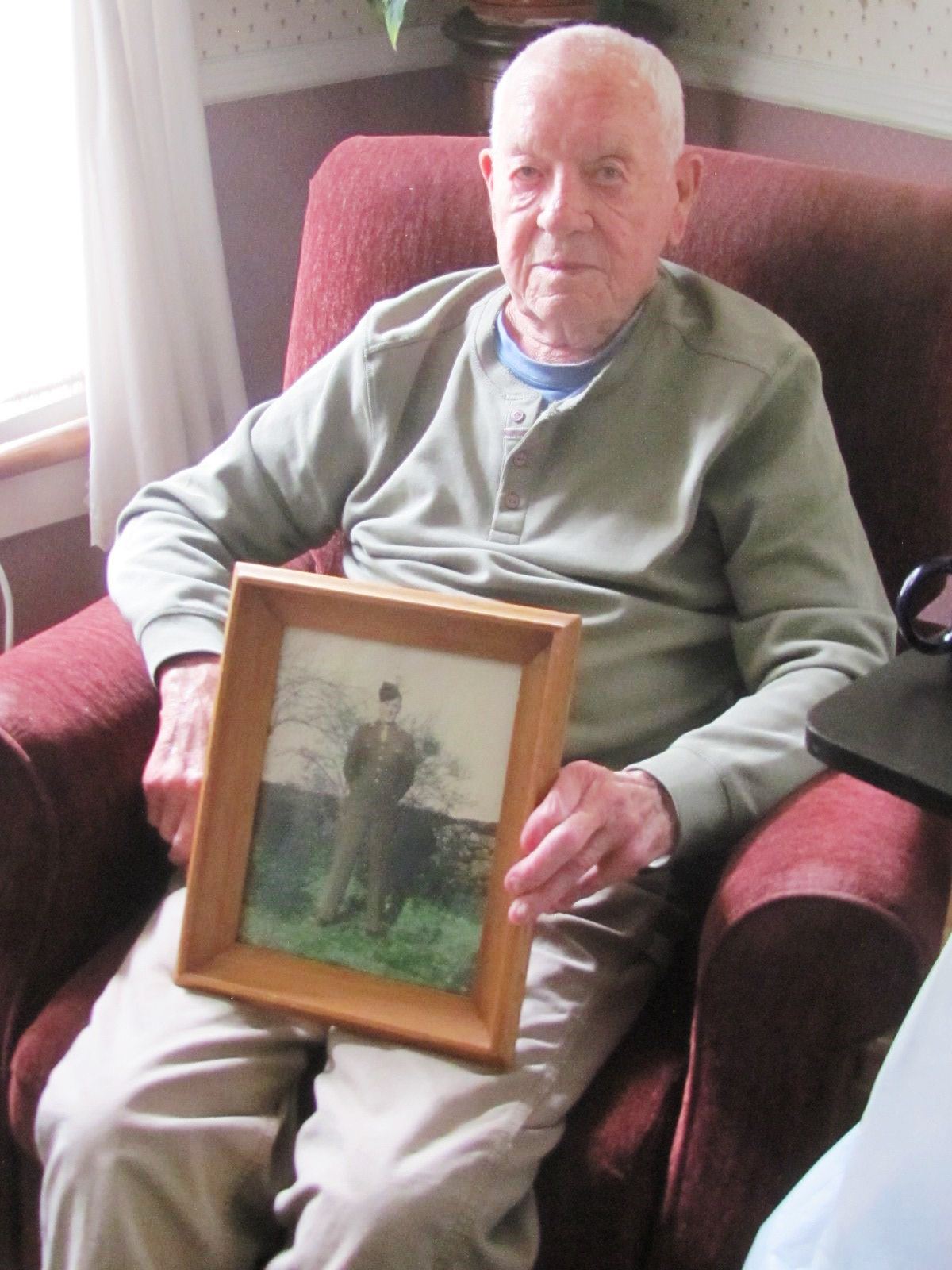
I first met Jim Carr about 25 years ago in Bellows Falls. Jim was always walking on Atkinson Street. Over time we became friendly. Jim is 98.
One day I was having a yard sale on Atkinson Street when Jim stopped in. On a table I had a few books for sale. I was standing beside Jim as he thumbed through a World War II book. Jim turned a page. On the two facing pages were Hurtgen Forest battle photos. Jim looked at them and said, “Yes.” Jim was there as a replacement in the 28th Division.
On Feb. 1, 1944, Jim turned 18. He was drafted soon after and sent to Fort Devens. At Devens, Jim ran into Paul Caron. Jim had known Paul when he was driving truck to Springfield, Mass. Paul worked for J.M. Giddings, delivering goods to A&P and Finast stores. Jim also met Bill Campbell that day. These three men served through the war, all three came home on the train together. They had survived.
England and France
Jim arrived in England. After a brief stay in England, Jim was sent to Le Havre, France, to a replacement depot. He was here three days, when he was sent to the 112th Infantry Regiment, E Company. Jim and Paul stayed in the same unit. Bill went to another squad, all as replacement riflemen. Jim was made a BAR rifleman. The BAR was a .30-caliber machine gun weighing 24 pounds.
Jim learned the previous BAR man had been killed the day before. I try to imagine being 18, in a foreign land, and handed a weapon whose previous owner was killed the day before. It had to be a sobering experience.
Winter of 1944-1945
Jim and Paul were sent to Hurtgen Forest, which was part of the Battle of the Bulge. In February 1945, Jim’s company was sent to the mountains of Colmar in France. It was bitter cold, with lots of snow. The men slept in foxholes, yet to be issued winter clothing. It was 20 below zero or colder. Try to imagine suffering this duty with only summer uniforms; very few had winter gear.
This past winter was rarely below zero. Imagine being dressed in summer clothing, sleeping out on your lawn during this below zero weather. Day after day, week after week, this was Jim’s life.
Jim’s feet were frostbitten. This is why Jim did so much walking when I first knew him. His feet never fully recovered. Walking kept the blood in his feet circulating.
Jim’s words
“One night we were tagged for a patrol to the village, and to check on the anti-tank crew that was there. We did not have much to eat except cold K rations. Tank men had C rations. C rations had bacon, all fancy stuff, and it came in a big can. I took a can of bacon, and when I got back to the hole, I could not cook it, as we could not have a fire. [Author’s note: having a fire would give away your position.]
“Our rations were called ‘K Rats.’ They consisted of a couple crackers, a chocolate bar, two cigarettes, and a small can of maybe ham and eggs, beef and potato. It was not fit to eat when cold. When we had the chance to ride on a truck, every time the truck stopped, we would put the small can on the manifold. The next time the truck stopped, the can would be warm and fit to eat.
“The supplies that came to us had to be brought up the mountain by mules and French Moroccans. This had to be done when the Germans could not see them, so it was seldom that we had rations.
“Finally, we were relieved by the 63rd Division, and the BAR man left his belt and clips lying on the ground and I grabbed them. I was sick of carrying only one clip. We did not have any good footwear, and these guys had had snow packs – L.L. Bean no less. Trench foot was a big thing at that time. Most of us carried a spare pair of socks under our shirt to keep them dry. We could not wash, brush our teeth, or change our clothes. We could not get out of our dugout to go to the bathroom, and had to use a wine bottle.
“After we came down from the mountains, the brass had volunteered our company to be armored infantry. Paul and I rode the tank. Paul manned the .50-caliber machine gun, and I still had the BAR. What a deal that was. It was still cold and wet. As we were going up a long hill approaching a small town, the last tank started to shoot at a farmhouse. There was a German tank at the house. We got it and we came into the town, and the bridge was blown up and around the area it was all mud…”
One summer day a few years ago I visited Jim. Jim showed me his vegetable garden. He had raised beds and containers for vegetables in a very small area. It was impressive to see. Jim has given it up today. When I asked Jim, he smiled and pointed to two five-gallon pails with tomato plants in his driveway. He has another container with a couple pepper plants. Never give up.
Jim and his wife Gloria have been married 74 years. It is an honor for me to know Jim and Gloria.